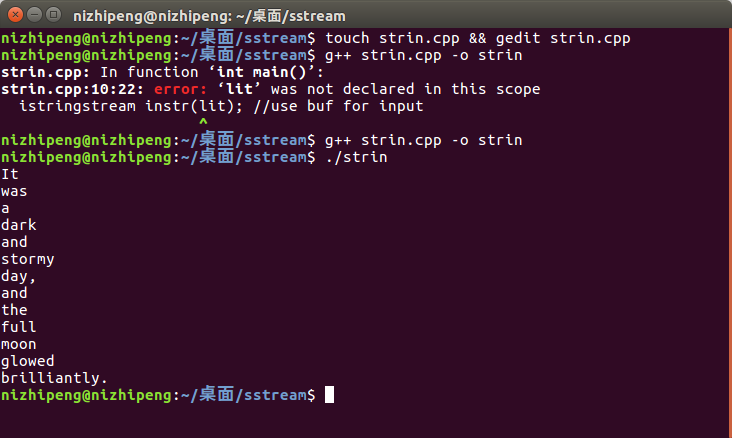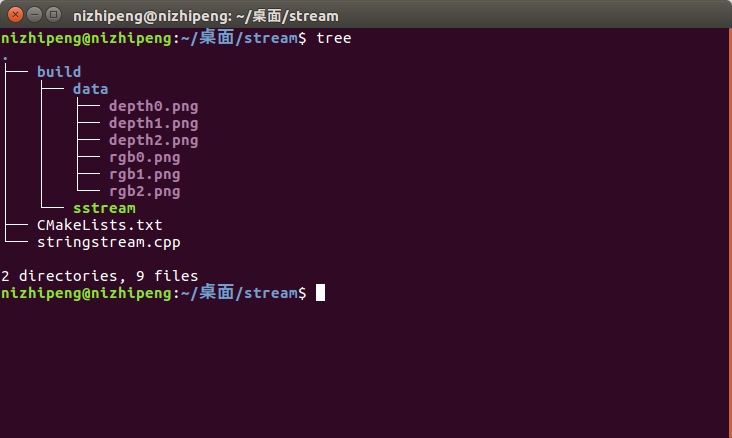参考《C++ Primer Plus》P788
iostream族支持 程序 与 终端 之间的I/O
fstream族支持 程序 与 文件 之间的I/O
sstream族支持 程序 与 string对象 之间的I/O,也就是说,可以使用cout的ostream方法将格式化信息写入string对象中,并使用istream方法(如getline())来读取string对象中的信息。读取string对象中的格式化信息或将格式化信息写入string对象中被称为内核格式化(incore formatting)。
ostringstream
#include <iostream> #include <sstream> #include <string> int main() { using namespace std; ostringstream outstr; string hdisk; cout << "What's the name of your hard disk? "; getline(cin, hdisk); // cin -> hdisk int cap; cout << "What's its capacity in GB? "; cin >> cap; // write formatted information to string stream //(格式化信息 -> string对象) outstr << "The hard disk " << hdisk << " has a capacity of " << cap << " gigabytes.\n"; string result = outstr.str(); cout << result; return 0; }
ostringstream类有一个名为str()的成员函数,该函数返回一个被初始化为缓冲区内容的字符串对象。
string result = outstr.str()
使用str()方法可以“冻结”该对象,这样便不能将信息写入该对象中。

istringstream
#include <iostream> #include <sstream> #include <string> int main() { using namespace std; string lit = "It was a dark and stormy day, and " " the full moon glowed brilliantly. "; istringstream instr(lit); //use buf for input lit -> instr string word; while (instr >> word) //read a word a time cout << word << endl; return 0; }
istringstream类允许使用istream方法族读取istringstream对象中的数据,istringstream对象可以使用string对象进行初始化。

应用

CMakeLists.txt
cmake_minimum_required( VERSION 2.8 ) project( stream ) # 添加c++ 11标准支持 set( CMAKE_BUILD_TYPE Release ) set( CMAKE_CXX_FLAGS "-std=c++11" ) # 寻找OpenCV库 find_package( OpenCV REQUIRED ) # 添加头文件 include_directories( ${OpenCV_INCLUDE_DIRS} ) add_executable( sstream stringstream.cpp ) # 链接OpenCV库 target_link_libraries( sstream ${OpenCV_LIBS} )
stringstream.cpp
#include <iostream> #include <fstream> #include <sstream> #include <opencv2/core/core.hpp> #include <opencv2/highgui/highgui.hpp> using namespace std; using namespace cv; void readFrame(int index); int main() { for (int i = 0; i < 3; i++) { readFrame(i); } return 0; } void readFrame(int index) { string dir = "./data/"; string rgb = "rgb"; string dep = "depth"; string Ext = ".png"; stringstream ss; ss << dir << rgb << index << Ext; // ./data/rgb1.png string filename; ss >> filename; Mat color = imread( filename );//rgb imshow(filename,color); //waitKey(0); ss.clear(); ss << dir << dep << index << Ext; // ./data/depth1.png filename.clear(); ss >> filename; Mat depth = imread( filename , -1);//depth imshow(filename,depth); waitKey(0); destroyAllWindows(); }
重点是:
ss << dir << rgb << index << Ext;
ss >> filename;
可以将字符串类型(rgb)和整数类型(index)拼起来,index不断更新,可以读取不同下标的文件。